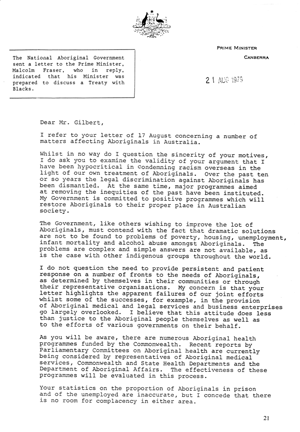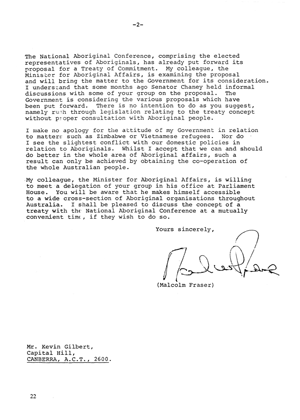Statement of historical facts on the NAC's 1980s Treaty framework

CLICK IMAGE TO VIEW FULL NEWSPAPER REPORT
The Canberra Times Wednesday 8th August 1979, Page 3 - Trove Newspapers

By Ghillar, Michael Anderson, Convenor of the Sovereign Union, 5 February 2021
Many of our People are now engaging in and considering Treaties with Australian State and Territory governments. Initial stages for a Treaty with the Commonwealth government and the National Aboriginal Conference (NAC) was agreed to by the Fraser Liberal Coalition government in 1979, after Kevin Gilbert and others set up the National Aboriginal Government (NAG) on Capital Hill, Canberra (before the new Parliament House was constructed), and called for a Sovereign Treaty and Bill of Rights.
Fraser's response to Kevin Gilbert was to send a Commonwealth car up to the camp to deliver the letter stating that his government was prepared to negotiate a Treaty, but this would be negotiated with the NAC as they were the nationally elected representative body at that time. The NAC was referred to by many as the Black Parliament.
I was employed by the NAC as the Director of Research to develop the Treaty framework.
The late Lyall Munro Senior, former NAC Chair, had a saying: "Currently we are the shadow government. If we succeed in negotiating a Treaty the lights will come on for the Australian society and we will come out of the shadows."
My role was not just to write up the national framework of such a Treaty, but also was to investigate the true legalities associated with Treaty-making and to this end the NAC sent me around the world over a couple of years to look at Treaties with First Nations that were already in existence, e.g. in Nigeria, Canada, America and Aoteroa. My final stop was to look at the Union that created the United Kingdom. To this end I travelled to England, Scotland Ireland and Wales, where I had high-level talks with government officials and members of the constitutional legal fraternity in order to gain and understanding of the Act of Union, 1707. What I learnt from this was that it was possible for the same thing to happen in this country, if there was a political will on the part of all the governments. Surprisingly enough, a senior Scottish lawyer associated with the House of Lords felt that it was good to see that Australia, through the Fraser Coalition government, was finally big enough to do the right thing by Australia's First Nations Peoples. The difficulty, however, with the Australian situation was that we have in excess of 300 First Nations, who have to be spoken with individually, where a proposal of this kind would be put to them for their consideration.
One of the key elements that I had discussions about was the fact that Australia was still 'owned' by the Crown of Britain, which claimed sovereignty of this continent. In this regard, there was one matter that had to be negotiated and that was the need for the NAC Executive to fly to London together with the Prime Minister, his Foreign Minister and Attorney-General, along with all State Premiers and Territory Chief Ministers and their Attornies-General to negotiate with the Crown and Parliament of Britain, as to what the Crown was prepared to concede. This was legally relevant because the Crown of Britain held and continues to hold the claim of sovereignty over Australia and no State or Territory was in a position to compromise the Crown's asserted interest. Only the Monarch representing the Crown had that capacity, for and with the advice of her Ministers and her Privy Counsel. Australian politicians possess no legal capacity to concede the sovereign monarch's interest in Australia. That decision had to come from Britain. Australia is bound to Britain by its Constitution and the authority in that Constitution is vested with the British Crown.
At that time, the NAC was also continuing to run locally-based community consultations where the different types of Treaties and agreements were being explained to the People, as well as recording their demands, hopes and aspirations in terms of what they considered to be necessary to include as part of a comprehensive settlement through a Treaty. Reports of these Treaty meetings will be made available through the Sovereign Union website and Facebook posts through the coming months.
In 1981 a preliminary list of demands was framed by the NAC in order to indicate to the Federal Government of the findings of community-based First Nations Peoples and the 24 points highlighted the consistent demands, as were compiled from the community consultations of 1981.
Such was the fierce commitment of the NAC that we ensured that all member States of the former British empire were informed of our Treaty framework process together with our emerging preliminary demands from our First Nations constituents.
The following is the NAC's position as presented to the Commonwealth Heads of Government Meeting (CHOGM) on 30 September 1981. The document was personally hand delivered to each Head of State attending the CHOGM by the late Mr Lyall Munro Senior and myself at the Melbourne Town Hall.
| NAC Preliminary list of Aboriginal demands as a basis for negotiation of an Agreement/Treaty | ||||
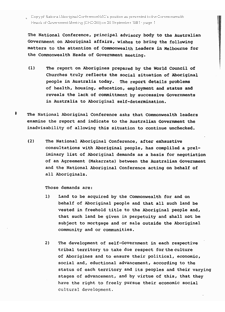 |
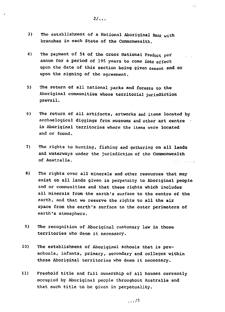 |
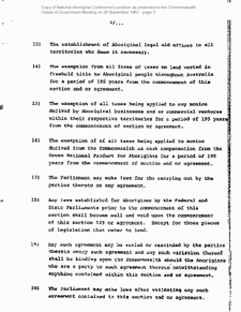 |
||
|
CLICK PAGE THUMBNAILS TO VIEW LARGER SIZE PAGES
|
||||
- The report on Aborigines prepared by the World Council of Churches truly reflects the social situation of Aboriginal people in Australia today. The report details problems of health, housing, education, employment and status and reveals the lack of commitment by successive Governments in Australia to Aboriginal self-determination.
The National Aboriginal Conference asks that Commonwealth leaders examine the report and indicate to the Australian Government the inadvisability of allowing this situation to continue unchecked.
- The National Aboriginal Conference, after exhaustive consultations with Aboriginal people, has compiled a preliminary list of Aboriginal demands as a basis for negotiation of an Agreement Makarrata between the Australian Government and the National Aboriginal Conference acting on behalf of all Aboriginals.
1. Land to be acquired by the commonwealth for and on behalf of Aboriginal people and that all such land be vested in freehold title to the Aboriginal people and, that such land be given in perpetuity and shall not be subject to mortgage and or sale outside the Aboriginal Community and or communities.
2. The development of self-Government in each respective tribal territory to take due respect for the culture of Aborigines and to ensure their political, economic, social and, educational advancement, according to the status of each territory and its peoples and their varying stages of advancement, and by virtue of this, that they have the right to freely pursue their economic social cultural development.
3. The establishment of a National Aboriginal Bank with branches in each State of the Commonwealth.
4. The payment of 5% of the gross National Product per annum for 195 years to come into effect upon the date of this section being given assent and or the signing of the agreement.
5. The return of all national parks and forests to the Aboriginal communities whose territorial jurisdiction prevail.
6. The return of all artifacts, artwork's and items located by archaeological diggings from museums and other art centre in Aboriginal territories where the items are located and or found.
7. the rights to hunting, fishing and gathering on all lends and waterways under the jurisdiction of the Commonwealth of Australia.
8. The rights over all minerals and other resources that may exist on all lands given in perpetuity to Aboriginal people and or communities and that these rights which includes all minerals from the earth's surface to the outer perimeters of earth's atmosphere.
9. The recognition of Aboriginal customary law in those territories who deem it necessary.
10. The establishment of Aboriginal schools that is pre-schools, infants, primary, secondary and colleges within those Aboriginal territories who deem it necessary.
11. Freehold title and full ownership of all houses currently occupied by Aboriginal people throughout Australia and that such title given in perpetually.
13. The establishment of Aboriginal legal aid offices in all territories who deem it necessary.
14. The exemption from all forms of taxes on land vested in freehold title to Aboriginal people throughout Australia for a period of 195 years from the commencement of this section and or agreement.
15. The exemption of all taxes being applied to any monies derived by Aboriginal businesses and or commercial ventures within their respective territories for a period of 195 years from the commencement of section or agreement.
16. The exemption of all taxes being applied to monies derived from the Commonwealth as cash compensation from the Gross National Product for Aborigines for a period of 195 years from the commencement of section and or agreement.
17. The Parliament may make laws for the carrying out by the Parties thereto on any agreement.
18. Any laws established for Aborigines by the Federal end State Parliaments prior to the commencement of this section shall become null and void upon the commencement of this section 129 or agreement. Except for those pieces of legislation that refer to land.
19) Any such agreement may he varied or rescinded by the parties thereto every such agreement and any such variation thereof shall be binding upon the Commonwealth should the Aborigines who are a party to such agreement thereto'notwithstanding anything contained within this section and or agreement.
20. The Parliament may make laws after validating any such agreement contained in this section end or agreement.
In 1982 Prime Minister Fraser provided an additional $3 million for the NAC to continue with their community consultations throughout Australia, in respect of ascertaining the type of demands that the grassroots people thought were important to be included in a Treaty. In 1983 Bob Hawke's Labor party was elected to office and the late Clyde Holding, Minister for Aboriginal Affairs, held meetings with the late Frank Walker, then NSW Attorney-general.
The NAC and the Commonwealth Department of Aboriginal Affairs were invited to participate in those discussions. Clyde Holding proposed that the NSW Land Rights Act 1983 should be viewed as a model for other State and Territory governments within Australia to follow.
The NAC expressed its views in that meeting at the NSW Parliament House that this was going at right angles to the NAC's development of a Treaty framework and could work to undermine the hard work that was being put into the Treaty to that date.
As a participating senior staff member at this meeting, I recall saying that this process of establishing State-based Land Rights laws would interfere with the demands of the Peoples, if it were to be set into State and Territory legislation's prior to the Treaty framework being finalised and negotiated with State and Territory governments.
The NAC's position was that State-based Land Rights legislation operated on the premise that a one-sized shoe will fit all. The NAC's community consultations on the Treaty suggested otherwise.
Without surprise, new staff were brought into the NAC after a political coup, that is the Federation of Land Council supporters -v- Grassroots selected delegates. Lines were drawn internally between those supporting the position of 'Sovereignty Never Ceded' and ultimate beneficial title to lands and waters as opposed to those who sought to gain Land Rights without sovereignty.
Unfortunately, these two positions continue to be the dividing wall for the current Sovereignty and Land Rights movement.
Needless to say, the Hawke Labor government was elected in March 1983 and by June 1995 the NAC was defunded and shut down.
 Contact: Ghillar Michael Anderson
Contact: Ghillar Michael AndersonConvenor of the Sovereign Union,
Head of State of the Euahlayi Peoples Republic
Contact Details here


